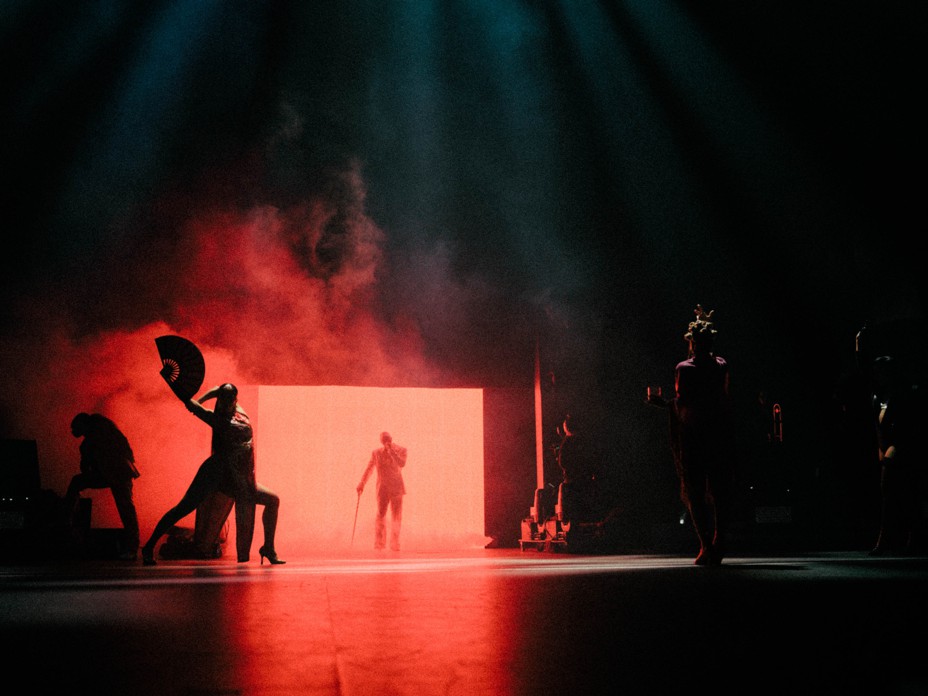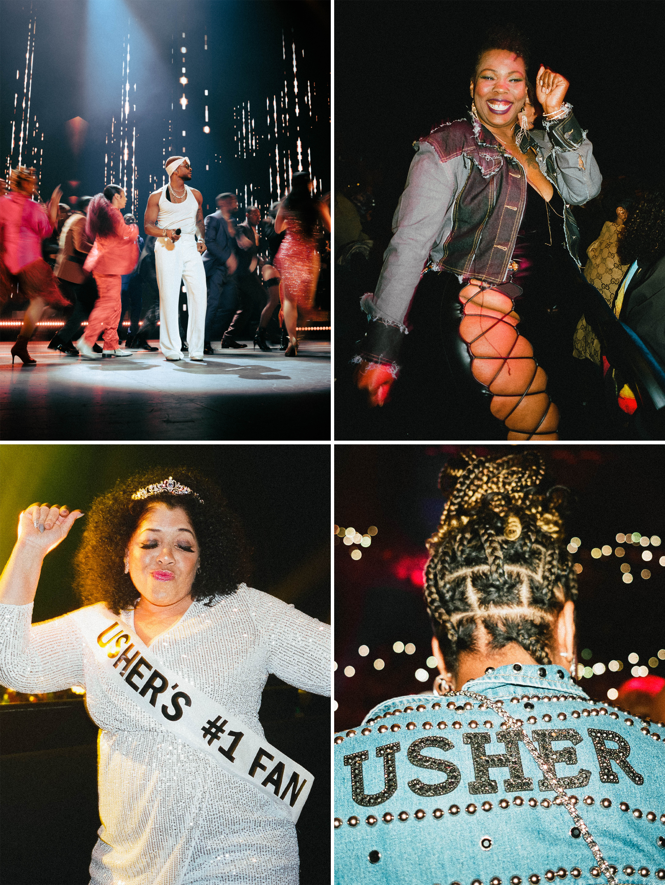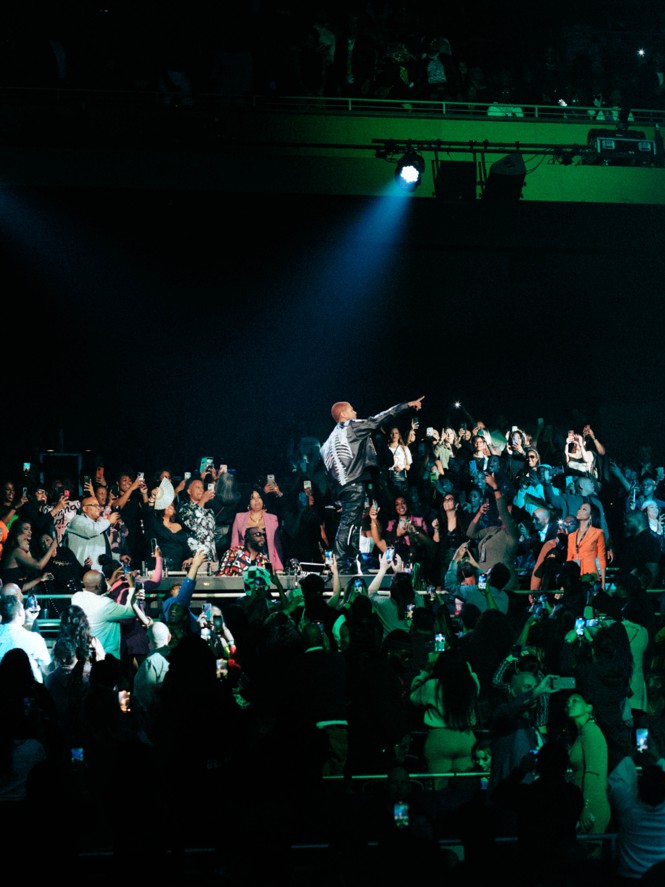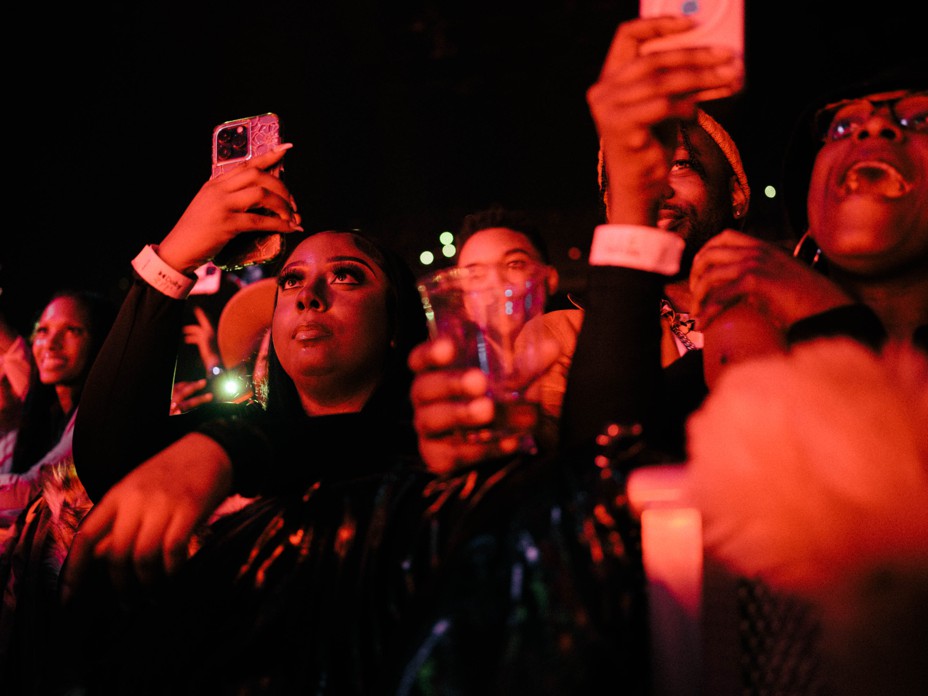Photographs by Chantal Anderson
The room where I’m set to meet Usher is glowing. I don’t mean that in a figurative sense, though the megastar certainly does luminesce in his own way. The space itself, a storefront-size chamber tucked away from the Las Vegas stage where he would perform that night, is awash in an almost eerie, LED blue. Along the far wall, light strips flank the liquor-covered bar, illuminating a step-and-repeat covered with $100 bills bearing Usher’s likeness. “The teal room,” as Usher and his team call it, is where the artist will later celebrate the spring kickoff of his new residency. I waited for him on a couch in the middle of the afternoon, leaning back against gold-lamé throw pillows, feeling as though I’d stumbled into a therapist’s office decorated to look like a strip club.
Into this uncanny scene walked Usher, the veteran R&B musician with a discography so obviously peerless that his only viable Verzuz competitor is himself. He strode into the room diamonds first, a thick chain around his neck sparkling against an all-black backdrop of sweatsuit, sunglasses, and durag. It wasn’t until he removed his sunglasses midway through our interview that I felt the weight of his celebrity, his innate sense that any room he walks into is distorted by his magnetism.
That night was a big night for Usher, an unveiling of sorts: the first official performance of the new leg of My Way, his residency at the Park MGM hotel and casino in Las Vegas. Much of his own family would be in the sold-out audience, along with fans who’d traveled from around the world to see him break into the infamous “U Remind Me” shadow choreography, sway his way through “You Make Me Wanna …” in a satin robe and leather pants, and strip the set bare to let his “Can U Handle It?” falsettos float.
Usher was fresh from a full-body workout when we met. He grew more animated as we talked. This is his second Vegas residency. In July of 2021, he became the first Black male singer to hold court at the famed Colosseum at Caesars Palace. This time around, he would have an even larger venue, and he wanted to do more than a standard concert. I asked him what to expect. He told me that without the burden of packing up a set, hopping onto a tour bus, and assembling it all over again across the country, he could run wild with My Way. He reminisced about the early days of planning the show. “We’re getting ready to light this bitch up,” he said.

A few hours after our conversation, in the giddy run-up to the show, I watched the crowd swell into the Dolby Live. The venue seats just over 5,000 people, a far cry from the 20,000-plus fans who have piled into a sold-out Madison Square Garden to see Usher over the years. To my left, standing nearly within reach of the stage, a woman in an silver monochrome outfit—sequined dress, metallic sneakers, princess tiara, and all—danced to Trap Beckham’s twerk-inducing “Birthday Bitch,” before pausing briefly to adjust the pageant sash draped across her chest, which proudly identified her as USHER’S #1 FAN.
Without giving away too much, Usher’s grand entrance hinges on a sly, crowd-centric interpretation of the song for which the residency is named. Just before he walks out to ear-piercing screams, in an all-white outfit set off by the same diamond chain he wore earlier that day, the last lines of the “My Way” chorus blare from the speakers. The lyrics set the tone for the rest of the show: “What I say goes / And I’m in control.”
Over the next two hours, he will skip across albums and eras, slipping into songs like costumes: One minute he is a sexed-up heartthrob, the next a wounded lover. He will push himself beyond traditional choreography into riskier stage work, including a few different set pieces on roller skates. During one, Usher and his dancers take to a medley of other artists’ hits—among them “Get Your Roll On” and “Drop It Like It’s Hot”—with the energy and precision of a college step team. Their moves are impressive, terrifying, fun. (Notably, the choreography involves none of the violence that reportedly broke out at an actual Las Vegas roller rink earlier this month, when Usher was allegedly assaulted by Chris Brown or a member of his crew before both singers performed at the seemingly jinxed Lovers & Friends Festival.)
Roller skates are an Atlanta thing—and not just in the movies. Cascade Family Skating, the real-life setting of T.I.’s 2006 classic, ATL, is one of more than a dozen rinks throughout the Atlanta metropolitan area where Black patrons have congregated for decades to dance and commune. After he unlaces his skates, Usher transports the audience to a decidedly less family-friendly Atlanta hallmark: Pole dancers descend from their elaborately designed perches with exhilarating speed. In one scene, a dancer approaches the stage to the sound of fight music. By the time she vaults herself onto the pole to begin her routine, the drum rolls have given way to the first notes of Usher’s timeless bad-bitch hype anthem, “Bad Girl.” Suspended upside down, the dancer claps her legs on beat as Usher sings the opening line that has supercharged women’s pregame primping for more than 20 years: What y’all know about a supermodel?
Later in the show, the same $100 “Ush bucks” I first saw in the teal room rain down from the ceiling. (What a delight it would’ve been for the bespoke currency to have cameoed alongside him in Hustlers.) Usher told me that, amid all the spectacle, he wants to make sure to situate the show within Atlanta’s larger cultural tradition. “I want you to always see that,” Usher said of the funk, the soul, the Blackness that makes the city a source of constant creative regeneration. “There is sophistication; there is a technical side to it that people should understand on the same level [as] Cirque du Soleil or any of the other kinds of theatrical things that come to Las Vegas. Atlanta has that, and we had that opportunity to be able to introduce it to the world here.”

Usher’s supporting cast hails largely from Atlanta and other parts of the South (including the show’s DJ, who has been a fixture in Usher’s performances for decades). In the teal room, Usher and his creative director Aakomon Jones, also the singer’s longtime choreographer, talked about the joy of channeling the city where they both got their artistic start as children. Jones told me that students would race out of their classrooms to share different moves “in between class, in the restroom, going over a routine before the bell rings, and you show up late,” he said with a smile, referencing a sense of childhood mischief that was deliberately built into My Way. “We cast for the legacy and the maturity, but then we also cast for the ‘dangerous’ youth energy,” Jones said of the performers onstage with Usher. “We build connective tissue between those generations.”
The show’s audience was intergenerational too. Parents brought their children; couples of all ages grooved together. Whether you were a toddler, a teen, or firmly into grown-n-sexy territory when “Nice & Slow” was first released, the opening chords entranced you all the same. The only time that mattered was 7 o’clock on the dot. For concertgoers such as myself, Usher has been creating an R&B canon since we’ve been forming memories. Thinking back on the pantheon of celebrity posters that graced teenagers’ bedroom walls in the aughts, I can’t remember many cover images that elicited as much libidinal adolescent fervor as that of Usher’s 8701. For fans who’d perhaps already swooned over the likes of Marvin Gaye, Teddy Pendergrass, and the Temptations well before Usher, the teenager boldly singing lyrics written by Babyface in the late ’90s didn’t exactly break the R&B sex-symbol mold. To them, the strikingly good-looking middle-aged man who now performed slow jams with generation-spanning charisma was once just such a handsome young man. One of the more unnerving things about Usher is that he’s arguably the only music-industry heartthrob who could still draw compliments like these from aunties.
After performing some of his highest-octane hits, Usher pared down the show for a mesmerizing stretch. No dancers, no elaborate set pieces. Just that voice and its acrobatics. Usher told me that he’d modeled his career path after athletes, not musicians. “Not many people know this, but my father was a basketball player and my mother was a basketball player,” he said. Watching them channel their energy into the sport, he figured that he could use that same focus to build something lasting for himself as a performer. In addition to ensuring that his body would always be in spotlight-friendly shape, that push toward athleticism also cultivated the agility he’d need to pull off signature flourishes such as his handstand choreography. “I didn’t look at myself like a dancer. I didn’t look at myself like a singer.” He saw himself more as Allen Iverson than Al B. Sure.

Watching the sheer exertion required of him in Vegas does feel a little like catching a glimpse of an athletic prodigy. Getting to that level takes diligent, unsexy work. “Mama Jan” Smith, an Atlanta-based vocal coach, has been training Usher for more than two decades. When he was first referred to her as a teenager (by Elton John, she believes), the industry veteran was struck by Usher’s clear talent: “He could dance with his voice,” she recalled. “And I don’t mean just dancing physically at the same time while he was singing. His voice also danced—it was his riffs and his runs, it was his tone.”
When Usher finishes singing “Climax,” the vocally taxing 2012 ode to a slowly dying relationship, the lights change. The artist is enveloped in a telltale haze of flame-colored smoke. “Burn” is coming, and the wait for it is deliciously agonizing. It is this emotional space that most distinguishes Usher. The sex appeal is always self-evident; the studied sentimentality is not. Across the My Way survey of his discography, he told me the three songs he considers quintessentially his are “Confessions” (no surprises there), “Burn,” and “Climax.”
Of the three, “Climax” admittedly gave me pause when he first named it. But during My Way, the song primes the crowd for “Burn” with its own dramatic flourish. With his tank top pulled up over his neck to reveal a still-statuesque upper body, Usher drops to his knees as he sings—“We’re going nowhere fast”—then falls to the floor as he lets the audience take over: “Come together, now we’re undone.”
By showcasing Usher’s willingness to come undone, “Burn” quickly became one of modern American music’s most enduring breakup records. The song was Usher’s initial choice for the Confessions lead single, which would ultimately be the inescapable Lil’ Jon– and Ludacris-assisted club banger “Yeah!” But along with that track, “Burn” was one of the key records keeping Usher at the top of the Billboard Hot 100 for nearly half of 2004. The ballad is undeniable, elemental R&B—romance refracted through the lens of grief. Any selection of lines from the song telegraphs anguish and depth, but the internal conflict of its bridge is Usher at his most exposed: “I’m twisted ’cause one side of me is tellin’ me that I need to move on / On the other side, I wanna break down and cry, ooh.”
Usher co-wrote “Burn” with the super-producer Jermaine Dupri, who has worked with him since 1997’s My Way, and the fellow producer Bryan-Michael Cox. On a recent call, Dupri told me that “Burn” is one of their collaborations on which Usher was most heavily involved in the conceptual process. He titled the song and gave Dupri the map before the producer ever sat down to write. Dupri anticipated “Burn” being a hit with women. After all, he figured, what woman doesn’t want to hear a man be vulnerable? But he never predicted how intensely it would resonate with men. Looking back on it now, Dupri happily acknowledges that he was wrong: “I think that’s the true secret to his success—that you have a man that actually is saying something that other men want to say.”
Usher sees songs like “Burn” as the centerpiece of his artistic legacy because they capture the devastation of heartbreak for men specifically. Since the song’s release, “Burn” has served as a lingua franca for a fragile kind of masculine pain. “It’s a very important role that I think I played in young men’s lives. And I obsess over it because I’m always trying to find the best way to articulate that emotion without making them feel uncomfortable,” he told me. “These are things that I think men need as tools.”
Given that it was released in the early aughts, when hip-hop and R&B were closely entwined but firmly distinct, “Burn” feels all the more poignant. Usher’s vocals in the song mirror its lyrics: He unravels, slowly and methodically creating a sound that feels cracked open. Just as the narrative doesn’t end with a neat resolution, his voice doesn’t rise with linear intensity. He remains raw. Exercising that kind of control, what Mama Jan referred to as “attaching emotional inference” to how one sings, is a deceptively difficult task. Doing so within a cultural climate that prioritized suave, swaggering braggadocio would have been all the more challenging.
It’s not altogether surprising, then, that “Burn” immediately broke through—or that it’s the song that draws the most impassioned response from concertgoers at the Vegas show. Every night, Jones said, he looks out into the audience and sees “the hardest of the hard still singing the lyrics to the love ballad.”

As Usher nears the end of “Burn,” he invites the audience to sing the falsetto-filled bridge with him. No one in the room matches his tone, but our shared sense of release fills in where our harmonies do not. The crowd cools down, the beat drops, and Usher issues the now-memefied directive “Watch this” before beginning a song that sends the energy in the room skyrocketing. When we spoke a few weeks later, Dupri pointed out a statistic that “sounds like a dinosaur to me”: Almost 20 years later, Confessions is still the last R&B album to ever be certified diamond.
For many musicians, producing a genre-defining work like Confessions at just 25 could lead to some real complacency. But after that album, Usher kept grinding. In 2008, he released Here I Stand, a ballad-heavy record that trades the debauchery of Confessions for declarations of love inspired by his relationship with his then-wife, Tameka Foster. Two years later, after they’d parted ways, he put out the aptly named divorce manifesto Raymond v. Raymond. Both albums debuted at No. 1 on the Billboard 200 chart. As the R&B star solidified his standing in the music industry, he also dipped his toe into other genres. The dance-pop single “OMG,” an Auto-Tune-heavy will.i.am collaboration, clinched the No. 1 spot on Billboard’s Hot 100 for four weeks in 2010. And the years that followed saw him collaborating with an eclectic array of popular artists including Pitbull, Enrique Iglesias, Rick Ross, Nicki Minaj, Young Thug, and Diplo. The hits rolled in.
In the lead-up to Usher’s residency at Caesars Palace, the musician was still massively popular but creatively adrift. It had been almost five years since he’d released a solo album, 2016’s thematically incohesive Hard II Love, also his first LP since My Way without a massive hit. On the path to becoming a megastar, to selling out arenas and courting crossover appeal, he’d lost his passion for creating music and felt less connected to his fans than in the past. “I had stopped caring, because I had done it for so long and just obsessed over success,” he told me. He found himself constantly “trying to figure out how to create something that everybody is going to love, because my audience had grown so much.”
The beautiful thing about being able to slow down in Vegas, he says, is that it made him care about the music again. When Usher performs now, he sees an audience respond with rapturous enthusiasm to the R&B that first catapulted him to fame—before the EDM chart-toppers, the Justin Bieber career coaching, or the “revolutionary pop” that earned him a wider fan base and the ire of some early fans who felt abandoned by his moves outside the genre. Onstage and in his new music, Usher is channeling the glory of an earlier R&B era. In March, he even released “GLU,” a sexy, falsetto-filled teaser for the forthcoming album that fans have anticipated as a kind of Confessions 2. (The full record is slated for release later this year.) As Usher told me, “I needed to come to Las Vegas to just get to the place where I was having fun again.”
As My Way wound down, I observed the faces around me. Overwhelmingly, the audience seemed united in feeling, not thought. People danced in the aisles and serenaded one another from their seats. Back in the teal room, Usher had recalled a scene almost like this one, which had brought the meaning of his career—and the immensity of this residency—into sharp relief. While performing, he said, he saw his son, his mother, and his grandmother all reveling in the audience. His son, now a teenager, had recently experienced something that made “Burn” feel like more than just one of his dad’s old songs. That night, he understood. “It was a tender moment for me,” Usher said. “I could see him singing it, and he’s really singing it.”
